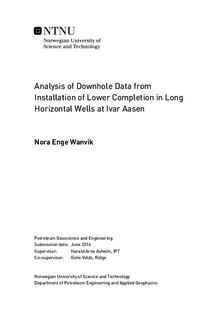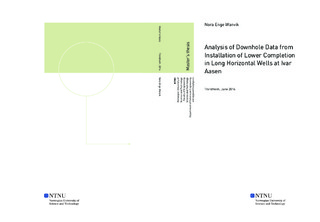| dc.description.abstract | In recent years, there has been a significant development in logging tools designed to acquire information of the downhole events during drilling operations. This development has not been as significant in completion operations, making it difficult to analyze successes and failures that occur downhole due to the lack of data. The i-Con Drill String Dynamics Logging Tool has been developed by Trican Completion Solutions to be used for downhole data acquisition in wells during completion operations. It contains sensors that measure downhole parameters such as pressure inside the installation string, annular pressure, torque, temperature and axial loads.
As of June 2016, the i-Con tool has been run during the installation of lower completion in five wells at the Ivar Aasen Field. The wells are all long, horizontal oil producers from 4600 m MD to 6200 m MD, completed with sand screens. During the installation, the tool was located directly above the liner hanger running tool as this was the main point of interest in the well.
The downhole data acquired by the tool in the five oil producers was analyzed, with particular attention payed to five specific downhole events:
1 - Installation of the lower completion
2 - Anchoring the lower completion
3 - Circulation through the lower completion 4 - Isolating the lower completion
5 - Pressure testing the lower completion
The goal of this analysis was to determine the typical fingerprint behavior for each event, and to evaluate areas of improved visibility that appear when using downhole data in addition to surface data. In order to achieve this, plots were made in Microsoft Excel. Some plots show all data from the lower completion installations, while others only display relevant data for each downhole event.
The main findings based on the analysis include that there are clear fingerprint behaviors for several variables in many of the downhole events. The acquired downhole data provides new information to draw a more complete picture of the downhole events taking place in the five oil producers at Ivar Aasen. Another more general conclusion is that downhole data sets like these can be used to adjust and optimize future completion operations. It also provides documentation and verification that tools have run through their intended cycles and operations. Verification like this have become more demanded post Macondo. | |

